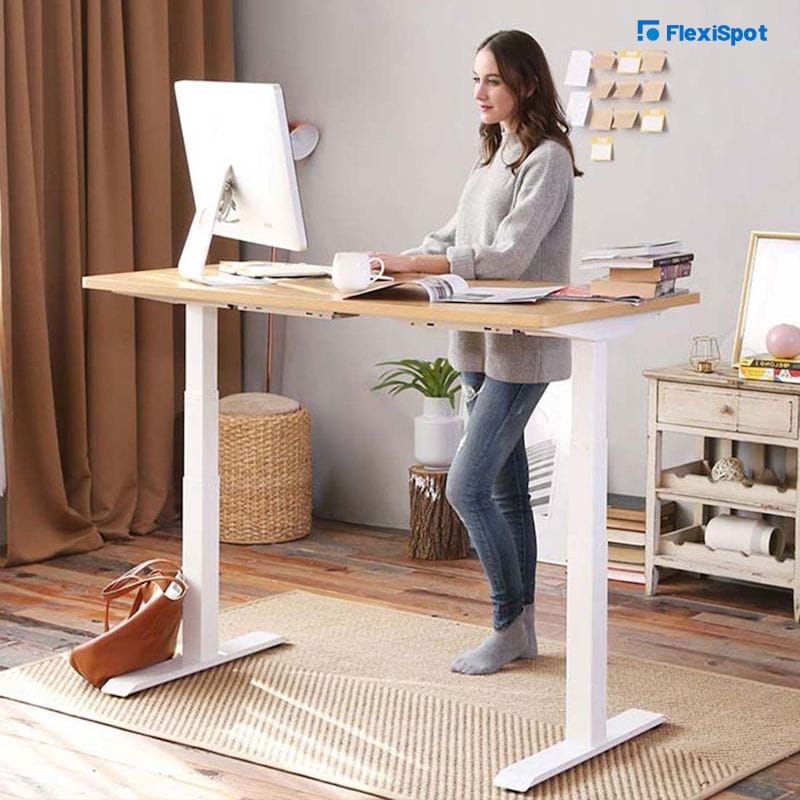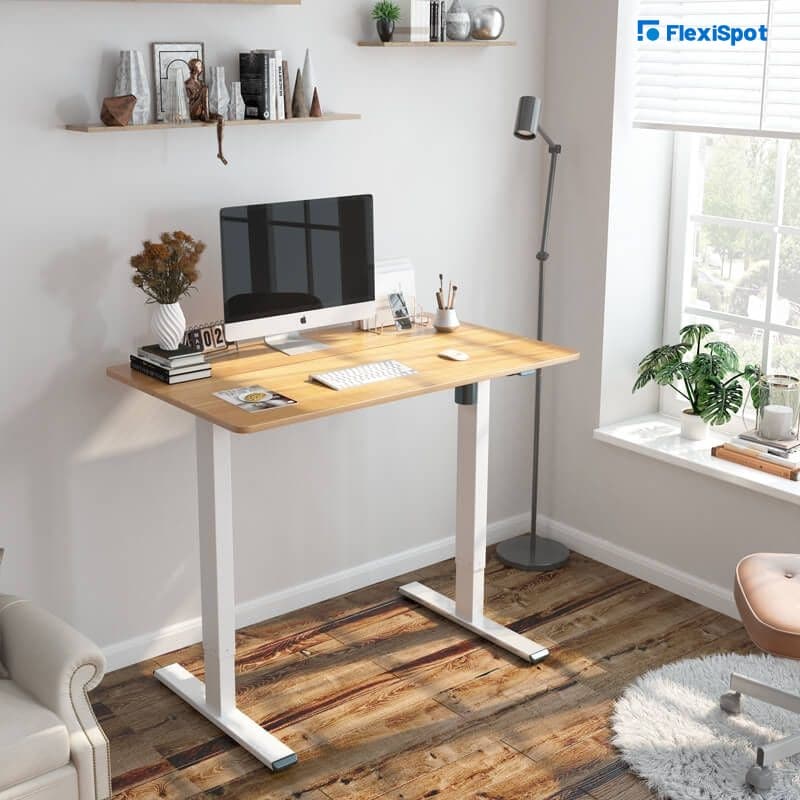Did you know working for long hours in uncomfortable positions can affect your body in more than one damaging way? Have you ever felt backache, sore shoulders, or stiff neck after spending a long day at work? Research has shown that sitting or standing for extended periods does a lot of harm to your back, spine, shoulders, and neck. It is no surprise that most of the discomfort you feel after a long and tiring day at work actually stems from using poor ergonomic products in the workplace.
This article will serve as a guide and help you style your office using ergonomic products. We will share the key areas you need to focus on when styling your office and some must-haves you need to get your hands on.
Let’s get started!
An Ergonomic Approach to Office Design
While furniture and equipment are essential dimensions of workplace ergonomics, a good office designer will always take an integrated approach and integrate ergonomics with every element of styling an office.
An ergonomic office layout ensures all workstations, conference rooms, meeting areas, boardrooms, bathrooms, kitchens, and storage spaces are optimally designed for the wellbeing of all employees. An experienced designer will use scientific principles to make the best possible use of the office space available and tailor workstations according to users and their jobs.
Styling an office ergonomically includes spacing workstations appropriately, so employees have enough space to move between them. It also involves sizing meeting tables and chairs to maximize the number of people who can use them comfortably.
Ergonomic lighting can also significantly impact employee wellbeing and office style, just like ergonomic furniture. Poor or insufficient office lighting can lead to eye strains. These strains can cause blurred vision, headaches, neck pain, itchiness, and sleep issues. If there’s too much natural light in front of or behind a workstation, it can cause difficulty viewing screens because of glare. A skilled office designer will ensure just the right amount of ambient office lighting in every corner of the workplace.
4 Areas of Focus for an Ergonomic Office
When you sit in a car for the first time, you make adjustments to the seat to fit your body, don’t you? Similarly, you should also customize your office according to your body’s positioning and preferences. This section will discuss four key areas you need to focus on to create an ergonomic office space:
1. Head and Neck
To avoid injuring your shoulders, neck, or back, you must always position your head vertically with your neck. This position creates the least amount of strain on your body parts.
However, if you work on your laptop computer placed on your kitchen island, the screen will be too low, and you will naturally flex your neck forward, creating strain. While this is probably harmless for a short period, you should consider making some changes for a long-term setup.
Consider mounting it on a laptop stand or riser and using an external keyboard and mouse if you use a laptop. If you have a monitor setup, use a monitor arm to raise it to a comfortable eye level so your head and neck stay in a stacked, vertical position.
2. Hand, Arm, and Wrist Position
When working on a desk, you should always place your hands and wrists in a neutral posture, just like your head. Extend your arms and hands forward to lay them flat on your desk. Your hand, wrist, and forearm should be straight at one level. You must not have a hinge at the wrist. Your arms shouldn’t bend out to the side or across the midline of your body.
Whatever devices or gadgets you use, ensure you use them with your hands, wrists, and arms in a neutral position. If they’re not in a neutral position, you must adjust your workspace accordingly. Try changing the height of your desk or chair, if possible. See if moving your keyboard or mouse closer or further away helps.
3. Seated Posture and Lumbar Support
A very common myth about seated posture is that you must always sit at a 90-degree angle with the trunk of your body perpendicular to the floor. Ergonomic experts have spent years telling people that’s not how they should sit. The best way to sit on a desk is to find a posture that allows you to see your screen while sitting back for lumbar support. You might find it similar to sitting in a car’s driving seat with your body slightly leaning backward.
If you don’t have the budget to buy a fancy leather ergonomic office chair, you can try putting a cushion, pillow, or towel behind your lumbar region. You can look for inexpensive chair cushions designed to provide lower back support. We also suggest looking into orthopedic seats. They work with all chairs and tilt your pelvis into a more ergonomic position to help you achieve the right posture.
When you’re sitting down, ensure your seat is not hitting the back of your knees, as this can reduce blood flow to your knees and cause your ankles and feet to swell.
4. Work Behavior
Lastly, you also need to focus on behavior when designing an ergonomic office. During your working hours, take frequent short breaks. Here’s a glimpse of the ideal routine you should follow:
Take a short break to stand up, stretch and walk around for a minute or two after every 20 minutes. You can also use this time to make yourself a cup of tea or coffee. Moving frequently helps improve blood circulation and reduces the risk of injuries.
If possible, limit the length of time your body spends doing one repetitive action. For example, if your job involves excessive typing, consider using dictation software to give a break to your hands, arms and wrists. You will cut down the total time you spend using your keyboard.
If you know how to use them properly, it doesn’t hurt to invest in standing desks. Standing desks by FlexiSpot are the perfect upgrade for your workstation. They are easily adjustable and elegantly designed, keeping office ergonomics in mind.
However, you should keep in mind that too much of anything is bad for you. Just like sitting for extended periods can harm your body, so can standing for several hours at a time. Standing puts more strain on your body than sitting, so if you are going to use a standing desk, make sure you follow the 20-8-2 rule – 20 minutes of working seated on a chair followed by 8 minutes of standing and then 2 minutes of moving around. If you stand for more than 8 minutes at a time, you will naturally start leaning, which can harm your posture.
4 Ergonomic Must-Haves for Styling an Office
Are you looking for ergonomic products to style your home office or workplace? This section discusses four essential must-haves for ergonomic workspaces:
1. A Comfortable Chair
If you spend several hours at your desk every day, we suggest investing in an ergonomic office chair that provides lumbar support. We have tested several office chairs and concluded that FlexiSpot’s leather ergonomic office chair category has the best products on the market. All chairs in the category are adjustable to fit a variety of body types and sizes. They provide highly comfortable cushioning and lumbar support. They are made from upgraded leather and have metal bases. If you are looking for chairs that swivel or rock, get your hands on these!
2. A Desk at the Right Height
Traditional office desks are between 28 and 30 inches high. They are a good fit for people who measure 5 feet 10 inches or above. However, they are not ideal for shorter people since they don’t allow them to place their arms parallel to the ground. We recommend investing in an adjustable-height desk that will enable you to lower or raise the desk height according to your height. These desks also allow you to easily switch between sitting and standing at regular intervals while you work.
3. An Ergonomic Display
It is very important to protect your eyes from fatigue and strain. Ensure that you can see whatever’s on your monitor or laptop screen whether you're seated or standing. You shouldn't have to crane or bend your neck. Ensure your eye level is two to three inches below the top of your monitor screen. Your screen should always be an arm’s length away.
4. Good Lighting
Lastly, to style an ergonomic office, ergonomic experts suggest investing in ambient office lighting to reduce eye strain. Poor and insufficient lighting will force you to tilt your neck and look at the screen from an unnatural angle. Make sure there is plenty of natural lighting in your workspace. Natural lighting can boost your wellbeing and reduce eye strain. It also allows you to relax during work intervals.
Final Words
Ergonomics is all about productivity for employees and their managers trying to maximize employee ROI. Whether you are self-employed and working from your home office or commuting to the office, you can reduce strain and stress on your body by using ergonomic products.








